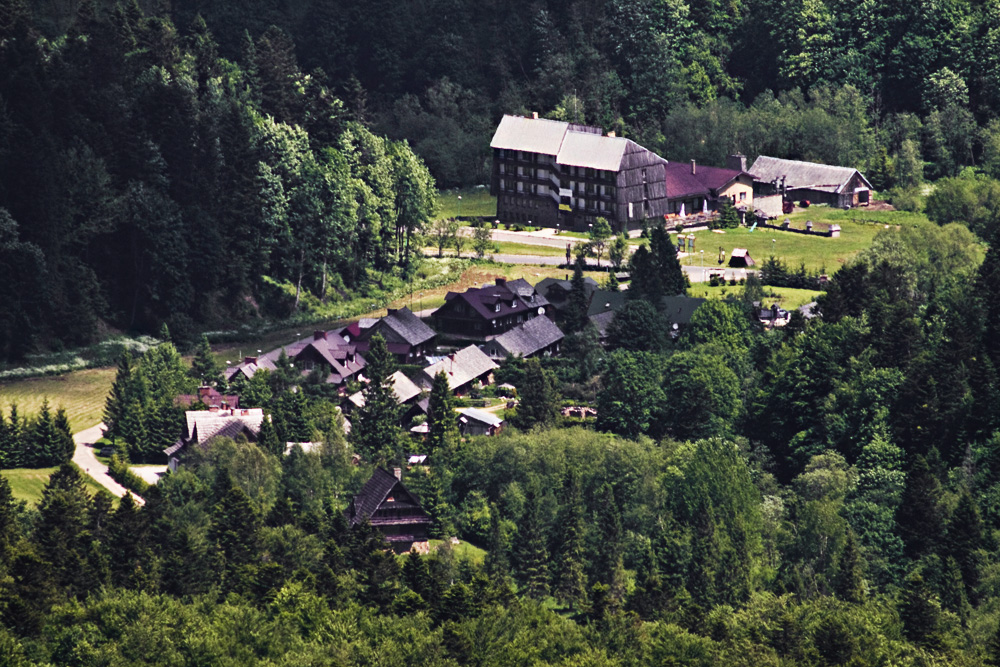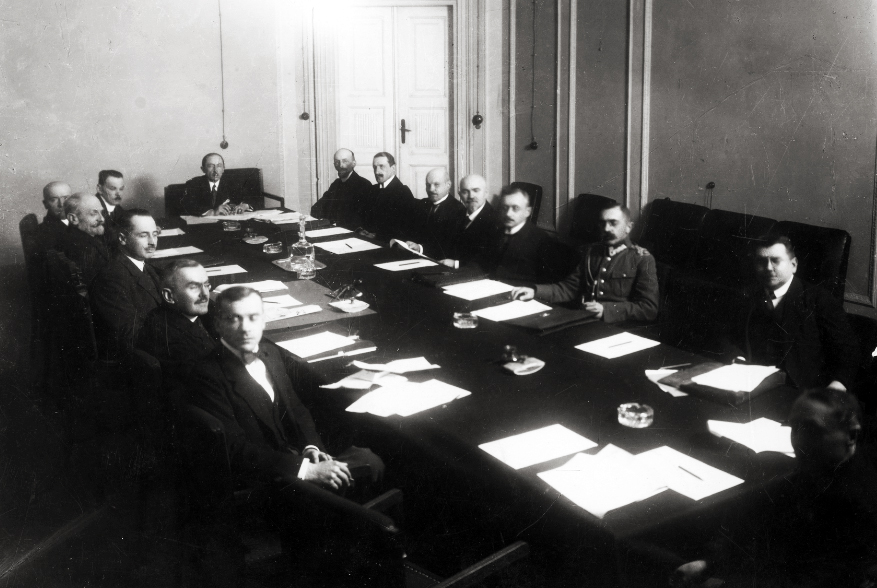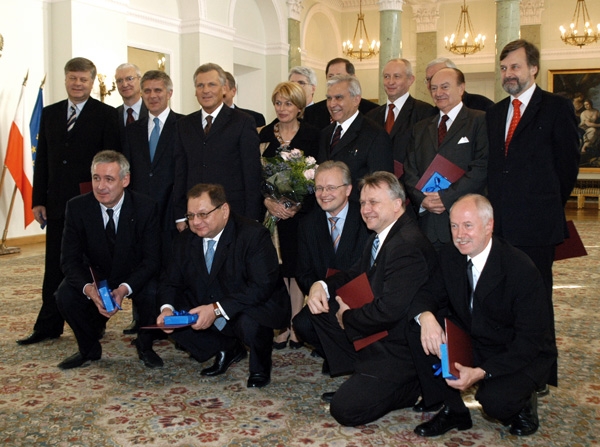|
Muczne
Muczne is a village in southeastern Poland in Subcarpathian Voivodeship, Bieszczady County, Gmina Lutowiska, near the border with the Ukraine, in the valley of the Muczny stream. It lies approximately south of Lutowiska, south of Ustrzyki Dolne, and south-east of the regional capital Rzeszów. In the former administrative division of Poland (1975-1998), Muczne was situated in Krosno Voivodeship. Mucze was on the trail of forest railway lines that led to Wołosate and Trebowiec valleys and it ended with Sokoliki Górskie railway station. Before World War II, Muczne was part of Dźwiniacz Górny village. In 1944, troops of Ukrainian Insurgent Army raided the village and murdered 70 people of Polish nationality in the Muczne massacre. Eventually, after the war, the village was deserted with all houses burnt-out. In the 1970s, there was a small dwelling for forest workers and, in 1975, the area was taken over by the Council of Ministers. Later, Muczne was turned into a farm ... [...More Info...] [...Related Items...] OR: [Wikipedia] [Google] [Baidu] |
Muczne
Muczne is a village in southeastern Poland in Subcarpathian Voivodeship, Bieszczady County, Gmina Lutowiska, near the border with the Ukraine, in the valley of the Muczny stream. It lies approximately south of Lutowiska, south of Ustrzyki Dolne, and south-east of the regional capital Rzeszów. In the former administrative division of Poland (1975-1998), Muczne was situated in Krosno Voivodeship. Mucze was on the trail of forest railway lines that led to Wołosate and Trebowiec valleys and it ended with Sokoliki Górskie railway station. Before World War II, Muczne was part of Dźwiniacz Górny village. In 1944, troops of Ukrainian Insurgent Army raided the village and murdered 70 people of Polish nationality in the Muczne massacre. Eventually, after the war, the village was deserted with all houses burnt-out. In the 1970s, there was a small dwelling for forest workers and, in 1975, the area was taken over by the Council of Ministers. Later, Muczne was turned into a farm ... [...More Info...] [...Related Items...] OR: [Wikipedia] [Google] [Baidu] |
Muczne Massacre
The Muczne massacre of 16 August 1944 was the massacre of Polish civilians committed by the Ukrainian Insurgent Army (UIA) in village Muczne located in Bieszczady County in Poland. Among the Poles were mainly refugees after the repression of the population in Volhynia and retreating in front of - 70 Poles were murdered. They were residents of nearby villages such as foresters, priests and children. Members of the UPA murdered Poles with axes, pitchforks and scythes. In place of the murder in 2010 the memorial and a wooden cross was erected. References Sources * Grzegorz Motyka Grzegorz Motyka (born 1967) is a Polish historian and author specializing in the history of Poland–Ukraine relations. Since 1992 he served at the Institute of Political Studies of the Polish Academy of Sciences and at the Institute of National ..., "Tak było w Bieszczadach. Walki polsko-ukraińskie w Polsce 1943-1948", Warszawa 1998 {{DEFAULTSORT:Muczne Massacre 1944 murders in Poland Mas ... [...More Info...] [...Related Items...] OR: [Wikipedia] [Google] [Baidu] |
Gmina Lutowiska
__NOTOC__ Gmina Lutowiska is a rural gmina (administrative district) in Bieszczady County, Subcarpathian Voivodeship, in south-eastern Poland, on the border with Ukraine. Its seat is the village of Lutowiska, which lies approximately south of Ustrzyki Dolne and south-east of the regional capital Rzeszów. The gmina covers an area of , and as of 2006 its total population is 2,197. The gmina contains part of the protected area called San Valley Landscape Park. Villages Gmina Lutowiska contains the villages, settlements and former villages of Beniowa, Bereżki, Brzegi Górne, Bukowiec, Caryńskie, Chmiel, Dwerniczek, Dwernik, Dydiowa, Dźwiniacz Górny, Hulskie, Krywe, Krywka, Łokieć, Lutowiska, Muczne, Nasiczne, Procisne, Pszczeliny, Sianki, Skorodne, Smolnik, Sokoliki Górskie, Stuposiany, Tarnawa Niżna, Tarnawa Wyżna, Ustrzyki Górne, Wołosate, Zatwarnica and Żurawin. Neighbouring gminas Gmina Lutowiska is bordered by the gminas of Cisna and ... [...More Info...] [...Related Items...] OR: [Wikipedia] [Google] [Baidu] |
Countries Of The World
The following is a list providing an overview of sovereign states around the world with information on their status and recognition of their sovereignty. The 206 listed states can be divided into three categories based on membership within the United Nations System: 193 UN member states, 2 UN General Assembly non-member observer states, and 11 other states. The ''sovereignty dispute'' column indicates states having undisputed sovereignty (188 states, of which there are 187 UN member states and 1 UN General Assembly non-member observer state), states having disputed sovereignty (16 states, of which there are 6 UN member states, 1 UN General Assembly non-member observer state, and 9 de facto states), and states having a special political status (2 states, both in free association with New Zealand). Compiling a list such as this can be a complicated and controversial process, as there is no definition that is binding on all the members of the community of nations concerni ... [...More Info...] [...Related Items...] OR: [Wikipedia] [Google] [Baidu] |
Krosno Voivodeship
Krosno Voivodeship () was a unit of administrative division and local government in Poland in years 1975–1998, superseded by Subcarpathian Voivodeship (except Biecz Commune which is now a part of Lesser Poland Voivodeship). Its capital city was Krosno. Major cities and towns (population in 1995) * Krosno (49,400) * Sanok (41,400) * Jasło (38,900) See also * Voivodeships of Poland , alt_name = province, state , map = , category = Provinces (unitary local government subdivision) , territory = Republic of Poland , start_date = , current_number = 16 voivodeships ... 1975 establishments in Poland Former voivodeships of Poland (1975–1998) History of Lesser Poland Voivodeship History of Podkarpackie Voivodeship {{poland-geo-stub ... [...More Info...] [...Related Items...] OR: [Wikipedia] [Google] [Baidu] |
Josip Broz Tito
Josip Broz ( sh-Cyrl, Јосип Броз, ; 7 May 1892 – 4 May 1980), commonly known as Tito (; sh-Cyrl, Тито, links=no, ), was a Yugoslav communist revolutionary and statesman, serving in various positions from 1943 until his death in 1980. During World War II, he was the leader of the Yugoslav Partisans, often regarded as the most effective resistance movement in German-occupied Europe. He also served as the president of the Socialist Federal Republic of Yugoslavia from 14 January 1953 until his death on 4 May 1980. He was born to a Croat father and Slovene mother in the village of Kumrovec, Austria-Hungary (now in Croatia). Drafted into military service, he distinguished himself, becoming the youngest sergeant major in the Austro-Hungarian Army of that time. After being seriously wounded and captured by the Russians during World War I, he was sent to a work camp in the Ural Mountains. He participated in some events of the Russian Revolution in 1917 and the ... [...More Info...] [...Related Items...] OR: [Wikipedia] [Google] [Baidu] |
Edward Gierek
Edward Gierek (; 6 January 1913 – 29 July 2001) was a Polish Communist politician and ''de facto'' leader of Poland between 1970 and 1980. Gierek replaced Władysław Gomułka as First Secretary of the ruling Polish United Workers' Party (PZPR) in the Polish People's Republic in 1970. He is known for opening communist Poland to the Western Bloc and for his economic policies based on foreign loans. He was removed from power after labour strikes led to the Gdańsk Agreement between the communist state and workers of the emerging Solidarity free trade union movement. Born in Sosnowiec, Congress Poland, to a devoutly Catholic family, Gierek emigrated with his relatives to France at a young age. In 1934, he was deported to Poland for communist advocacy and campaigning, but subsequently moved to Belgium to work as a coal miner in Genk. As a result, he was proficient in French, which benefited in pursuing his future political career. During the Second World War, Gierek was active ... [...More Info...] [...Related Items...] OR: [Wikipedia] [Google] [Baidu] |
Piotr Jaroszewicz
Gen. Piotr Jaroszewicz (; 8 October 1909 – 1 September 1992) was a post World War II Polish political figure. He served as the Prime Minister of Poland between 1970 and 1980. After he was forced out of office he lived quietly in a suburb of Warsaw until his murder in 1992. Life and career Jaroszewicz was born on 8 October 1909 in Nieśwież, in the Minsk Governorate of the Russian Empire (present-day Belarus). After finishing the secondary school in Jasło he started working as a teacher and headmaster in Garwolin. After the outbreak of World War II and the Nazi-Soviet alliance established by the Molotov–Ribbentrop Pact he moved to Soviet-occupied zone of Poland. It has been claimed that he was a headmaster in Pinsk gymnasia. However, on 10 July 1940 he was deported to Slobodka, Krasnoborski region, Arkhangelsk, from Stolin together with his first wife Oksana Gregorevna (born in Salov/Calow 1914) and daughter Olila (born 1940). In 1943 he joined the 1st Polish Army of Gen. ... [...More Info...] [...Related Items...] OR: [Wikipedia] [Google] [Baidu] |
Prime Minister Of Poland
The President of the Council of Ministers ( pl, Prezes Rady Ministrów, lit=Chairman of the Council of Ministers), colloquially referred to as the prime minister (), is the head of the cabinet and the head of government of Poland. The responsibilities and traditions of the office stem from the creation of the contemporary Polish state, and the office is defined in the Constitution of 1997. According to the Constitution, the president nominates and appoints the prime minister, who will then propose the composition of the Cabinet. Fourteen days following their appointment, the prime minister must submit a programme outlining the government's agenda to the Sejm, requiring a vote of confidence.Article 154, para. 2 Conflicts stemming from both interest and powers have arisen between the offices of President and Prime Minister in the past. The incumbent and seventeenth prime minister is Mateusz Morawiecki of the Law and Justice party. Morawiecki replaced Prime Minister Beata Szydł ... [...More Info...] [...Related Items...] OR: [Wikipedia] [Google] [Baidu] |
Council Of Ministers Of The Republic Of Poland
The Council of Ministers of the Republic of Poland ( Polish: ''Rada Ministrów Rzeczypospolitej Polskiej'') is the collective executive decision-making body of the Polish government. The cabinet consists of the Prime minister, also known as the Chairman of the Council of Ministers, the Deputy Prime Minister, who acts as a vice-chairman of the council, and other ministers. The current competences and procedures of the cabinet are described between Articles 146 to 162 of the constitution. Nomination The process of forming the council of ministers begins with the nomination of the Prime minister by the President of Poland.Article 154, para. 1 The Prime minister will then propose the composition of the cabinet, which must then be approved by the president. Despite the president's nominating role in choosing a Prime minister and approving the composition of the cabinet, however, the presidency's role is strictly limited, as the president must respect the majority wishes of the Sejm. Ga ... [...More Info...] [...Related Items...] OR: [Wikipedia] [Google] [Baidu] |
Ukrainian Insurgent Army
The Ukrainian Insurgent Army ( uk, Українська повстанська армія, УПА, translit=Ukrayins'ka povstans'ka armiia, abbreviated UPA) was a Ukrainian nationalist paramilitary and later partisan formation. During World War II, it was engaged in guerrilla warfare against the Soviet Union, the Polish Underground State, Communist Poland, and Nazi Germany. It was established by the Organization of Ukrainian Nationalists. The insurgent army arose out of separate militant formations of the Organization of Ukrainian Nationalists—Bandera faction (the OUN-B), other militant national-patriotic formations, some former defectors of the Ukrainian Auxiliary Police, mobilization of local populations and others.Vedeneyev, D. Military Field Gendarmerie – special body of the Ukrainian Insurgent Army'. "Voyenna Istoriya" magazine. 2002. The political leadership of the army belonged to the OUN-B. It was the primary perpetrator of the ethnic cleansing of Poles in V ... [...More Info...] [...Related Items...] OR: [Wikipedia] [Google] [Baidu] |




